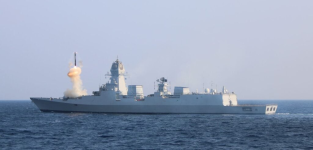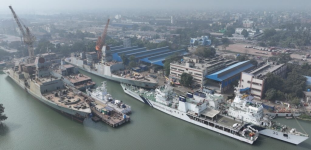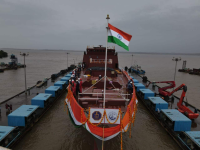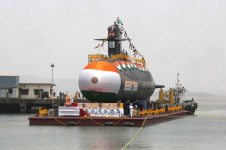The Indian Navy is set to embark on a large expansion plan with 50 warships under construction of the 66 contracted. 50 warships are at various stages of construction, varying from block fabrication to ships ready for sea trials. 48 of these are being constructed at six shipyards in India with the other two being built at Yantar in Kaliningrad, Russia. These projects cover vessels with a combined tonnage of over 200,000 tons, and worth over 1.1 lakh crore INR ($13 billion). 12 of these vessels are set to be delivered in the next 12 months. These 12 consist of one destroyer, five frigates, one submarine, two corvettes, and three survey vessels.


INS Imphal firing BrahMos-ER before commissioning (Indian Navy Photo)
Project 15 Bravo (Visakhapatnam class) destroyers are the follow-on of Project 15 Alpha (Kolkata class). Visakhapatnam and Kolkata class form the basis of modern surface combatants in the Indian Navy, equipped with vertically launched Surface-to-Air Missiles and long-range cruise missiles. Mazagon Dock has already delivered three of the four destroyers contracted, at the rate of one destroyer per year. The fourth and last ship, Surat, started sea trials in June 2024. MDL plans to deliver the last ship in this calendar year, taking the number of destroyers in the fleet to thirteen. The Indian Navy plans to add another eight Next-Generation Destroyers (NGD) to its fleet, replacing the ageing Rajput and Delhi class destroyers.

Himgiri and Dunagiri, under construction at GRSE in June 2024 (GRSE photo)
Project-17 Alpha (Nilgiri class) frigates are the follow-on of Project 17 (Shivalik class), the project of seven ships has been divided between two shipyards with MDL scoring four and GRSE scoring three vessels. The lead ship at both the shipyards has received their compliment of MF-STAR as well as UVLM. The lead ship being constructed by MDL, Nilgiri, started its basin trials recently and is scheduled to be delivered in the current financial year 2024-25. MDL also hints at the possibility of delivering the second ship, Udaygiri, by the end of the financial year 24-25 given it can start the basin trial in Q3 (September-December) this year. Himgiri, the first ship under GRSE, stands at 75% progress in physical construction and is being readied for harbour trials. The shipyard is targeting a delivery date in Q2 of FY25-26. The Indian Navy is already working on a follow-on of the P-17A frigates in the form of Project 17 Bravo, the new ships will feature higher indigenous content and long-range surface-to-air missiles. The project comprising 7-8 vessels is valued at around 70,000 crore INR ($8.3 billion), the Request For Proposal is expected to be issued by the Indian Navy around September 2025.

Launch of GSL’s lead ship, Triput (Indian MoD photo)
Indian Navy has concluded a contract for four follow-on Talwar class frigates based on the Grigorovich class of the Russian Navy, worth $2.5 in 2019. The four frigates will feature higher indigenous content with an Indian Combat Management System, UVLM for BrahMos, Electronic Countermeasure System (Shakti) and Hull Mounted SONAR (HUMSA NG). The ships will also feature 24 vertically launched Shtil1 missiles for anti-aircraft and anti-missile defence, compared to a single-arm launcher on the previous six ships.
The Yantar shipyard is expected to deliver the first ship in September 2024 with the second in February 2025. The two ships are undergoing a series of sea trials before delivery to the Indian Navy. GSL is building two of the follow-on frigates in India, it recently launched the first ship, Triput, which is expected to be delivered in 2026 with the second ship in the following 6 months.
The Indian Navy also plans to upgrade its existing fleet of six Talwar class frigates with the new combat management system, MF-STAR and MR-SAM, to bring them on par with new builds and to deal with modern threats.

Project-75, contracted in October 2005 is coming to a close with the delivery of the sixth and last submarine of the class, Vagsheer. The submarine started its sea trials in May 2023 and encountered some unprecedented issues in the delivery of some key sub-components, which hindered the submarine’s trial as well as delivery. The submarine is expected to be delivered by December 2024.
The Indian Navy plans to upgrade its Kalvari class submarines with the fuel-cell-based Air Independent Propulsion (AIP) system developed by DRDO and produced by L&T. L&T and DRDO signed a contract for the realisation of two Air Independent Propulsion (AIP) System Modules for Kalvari class submarines in June 2023. The fitment of the DRDO AIP on the submarines will begin with the lead ship set for its maiden overhaul and refit in 2025. Mazagon Dock has submitted the price bid for three additional Kalvari class submarines worth around 30,000 crore INR, which will feature the AIP and an advanced SONAR suite developed by DRDO. The deal is expected to be signed in the financial year 24-25, with delivery beginning around 2030.
The Indian Navy is also building five 44,700-tonne replenishment ships to add to its existing fleet of four, which will help support its million-tonne fleet. It is also improving its weapons with the development of 250km class surface-to-air missiles, active towed array SONAR, 6-meter S-band radar, hypersonic cruise missiles, ballistic missile interceptors, and several other technologies that will help it reduce dependence on foreign countries.

Visakhapatnam Class Destroyer

INS Imphal firing BrahMos-ER before commissioning (Indian Navy Photo)
Project 15 Bravo (Visakhapatnam class) destroyers are the follow-on of Project 15 Alpha (Kolkata class). Visakhapatnam and Kolkata class form the basis of modern surface combatants in the Indian Navy, equipped with vertically launched Surface-to-Air Missiles and long-range cruise missiles. Mazagon Dock has already delivered three of the four destroyers contracted, at the rate of one destroyer per year. The fourth and last ship, Surat, started sea trials in June 2024. MDL plans to deliver the last ship in this calendar year, taking the number of destroyers in the fleet to thirteen. The Indian Navy plans to add another eight Next-Generation Destroyers (NGD) to its fleet, replacing the ageing Rajput and Delhi class destroyers.
Nilgiri Class Frigate

Himgiri and Dunagiri, under construction at GRSE in June 2024 (GRSE photo)
Project-17 Alpha (Nilgiri class) frigates are the follow-on of Project 17 (Shivalik class), the project of seven ships has been divided between two shipyards with MDL scoring four and GRSE scoring three vessels. The lead ship at both the shipyards has received their compliment of MF-STAR as well as UVLM. The lead ship being constructed by MDL, Nilgiri, started its basin trials recently and is scheduled to be delivered in the current financial year 2024-25. MDL also hints at the possibility of delivering the second ship, Udaygiri, by the end of the financial year 24-25 given it can start the basin trial in Q3 (September-December) this year. Himgiri, the first ship under GRSE, stands at 75% progress in physical construction and is being readied for harbour trials. The shipyard is targeting a delivery date in Q2 of FY25-26. The Indian Navy is already working on a follow-on of the P-17A frigates in the form of Project 17 Bravo, the new ships will feature higher indigenous content and long-range surface-to-air missiles. The project comprising 7-8 vessels is valued at around 70,000 crore INR ($8.3 billion), the Request For Proposal is expected to be issued by the Indian Navy around September 2025.
Talwar Class Follow-on

Launch of GSL’s lead ship, Triput (Indian MoD photo)
Indian Navy has concluded a contract for four follow-on Talwar class frigates based on the Grigorovich class of the Russian Navy, worth $2.5 in 2019. The four frigates will feature higher indigenous content with an Indian Combat Management System, UVLM for BrahMos, Electronic Countermeasure System (Shakti) and Hull Mounted SONAR (HUMSA NG). The ships will also feature 24 vertically launched Shtil1 missiles for anti-aircraft and anti-missile defence, compared to a single-arm launcher on the previous six ships.
The Yantar shipyard is expected to deliver the first ship in September 2024 with the second in February 2025. The two ships are undergoing a series of sea trials before delivery to the Indian Navy. GSL is building two of the follow-on frigates in India, it recently launched the first ship, Triput, which is expected to be delivered in 2026 with the second ship in the following 6 months.
The Indian Navy also plans to upgrade its existing fleet of six Talwar class frigates with the new combat management system, MF-STAR and MR-SAM, to bring them on par with new builds and to deal with modern threats.
Kalvari Class Submarine

Project-75, contracted in October 2005 is coming to a close with the delivery of the sixth and last submarine of the class, Vagsheer. The submarine started its sea trials in May 2023 and encountered some unprecedented issues in the delivery of some key sub-components, which hindered the submarine’s trial as well as delivery. The submarine is expected to be delivered by December 2024.
The Indian Navy plans to upgrade its Kalvari class submarines with the fuel-cell-based Air Independent Propulsion (AIP) system developed by DRDO and produced by L&T. L&T and DRDO signed a contract for the realisation of two Air Independent Propulsion (AIP) System Modules for Kalvari class submarines in June 2023. The fitment of the DRDO AIP on the submarines will begin with the lead ship set for its maiden overhaul and refit in 2025. Mazagon Dock has submitted the price bid for three additional Kalvari class submarines worth around 30,000 crore INR, which will feature the AIP and an advanced SONAR suite developed by DRDO. The deal is expected to be signed in the financial year 24-25, with delivery beginning around 2030.
ASW Shallow Water Craft
Sixteen ASW-SWC are under construction for the Indian Navy at two shipyards, CSL and GRSE, with eight each. The shallow watercraft will help the navy perform ASW as well as Low-Intensity Maritime Operations (LIMO) near the coast. The design of both shipyards differs in terms of size but retains the same function and equipment. GRSE’s first SWC, Arnala, stands at 90% progress in the physical construction and has undergone harbour trials. The shipyard plans to deliver its first ASW-SWC by November 2024. CSL simultaneously launched three ASW-SWCs in November 2023, the first of which, Mahe, is expected to be delivered by the end of financial year 24-25. More SWCs can be delivered in the next 12 months, but only two can be confirmed at this point.Survey Vessel Large (SVL)
The Indian Navy signed a contract with GRSE for the supply of four survey vessels in October 2018. These survey vessels are capable of full-scale coastal and deep-water hydrographic surveys of ports and harbours, approaches and determination of navigational channels/routes. The ships will include a helicopter hangar to accommodate one Utility Helicopter Marine (UHM), as well as a containerized storage for Autonomous Underwater Vehicle (AUV). GRSE has already delivered the lead ship, Sandhayak, to the Indian Navy in December 2023. The second ship, Nirdeshak, has completed all trials and will be delivered in late August or early September. The remaining two are at 74% and 70% progress in the physical construction, with a delivery target of March and June 2025. Indian Navy plans to acquire an additional five Next Generation Survey Vessels to expand its hydrographic fleet.Conclusion
India needs a strong navy as it aspires to be the net security provider and preferred security partner in the Indian Ocean Region. To facilitate the expansion of its navy, the Ministry of Defence has doubled the capital budget of the navy from 26,000 crore INR to over 52,000 crore INR in the last five years. The Indian Navy will expand its fleet from a little over 100 to around 175 ships, including two aircraft carriers, 15 destroyers, 28 frigates, 24 submarines, and over 40 corvettes. The Indian Navy currently stands as the sixth-largest navy with a 600,000 tonne fleet and is well on its way to cross a million tonnes by 2035, and double to over 1.2 million tonnes by 2040.The Indian Navy is also building five 44,700-tonne replenishment ships to add to its existing fleet of four, which will help support its million-tonne fleet. It is also improving its weapons with the development of 250km class surface-to-air missiles, active towed array SONAR, 6-meter S-band radar, hypersonic cruise missiles, ballistic missile interceptors, and several other technologies that will help it reduce dependence on foreign countries.








